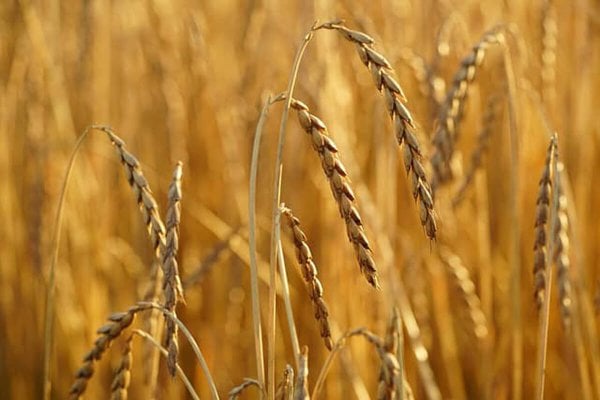
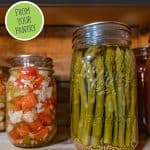
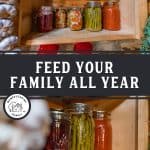
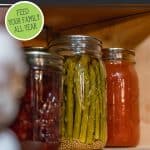
Building up a well-stocked and functional food storage system is a key skill and resource anyone should be developing, whether you’re a prepper or a homesteader… or not! Having one month, one year or 25 years of food storage is a good idea for so many reasons.
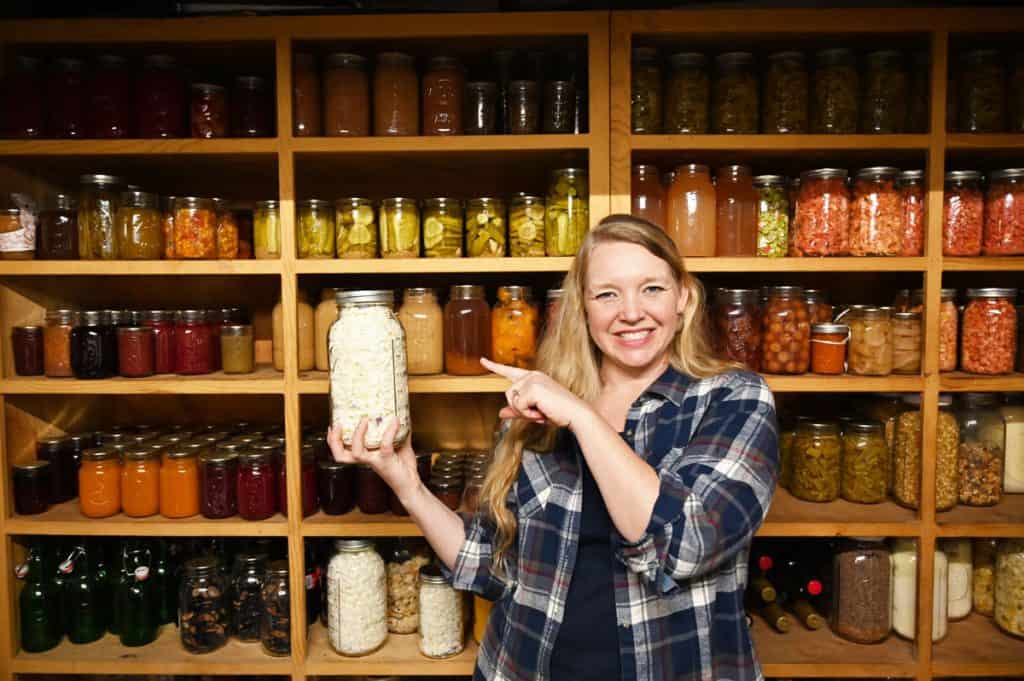
Having a long-term emergency food supply doesn’t always mean buying and storing staple items in bulk, canning your own meat or beans, preserving all your eggs, freezing or freeze-drying milk, or even raising and butchering your own meat and growing all your veggies (even though that might be your eventual goal).
Rather, having a long-term food supply available means you will save money and time, have greater food security and create less waste in your household.
Not to mention, as in present times, if/when a crisis arises, you will be prepared for inflation and will not need to panic shop when food sources are slim. As we discussed in this post on being prepared for an emergency, a long-term food supply is a significant portion of that preparedness.
This is a post that has been updated multiple times over the years as we discuss more methods for building up a food storage supply. The most recent update was my interview with Azure Standard CEO, David Stelzer.
About David Stelzer
David Stelzer is the founder and CEO of Azure Standard. David began farming organically as a teenager in the 1970s with a passion for providing truly healthful foods grown without conventional chemical inputs. From small beginnings, selling grain grown on the family farm, he founded Azure Standard in 1987 as a way to market not only what he grew but other products requested by his customers.
One attribute that sets David apart from many others is his willingness to do hard things. The saying, “When there’s a will, there’s a way” easily applies to David, since he has a knack for finding unique solutions to problems, and then earnestly working to make it happen, even when it’s not easy.
This has helped him earn the respect and admiration of his family, the Azure team, and so many others. But, his driving desire for action comes from something deeper than just making a living. His motivation comes from a personal passion to share healthful living with others.

Below, you’ll find tips for both HOW to build up your long-term food storage and WHY it’s important to do so. The tips are worth hearing whether you’re ready to jump in with both feet or you want to start slow and steady (on a budget).
Are you curious about what our long-term food storage supply looks like for a family of 13? Check out our full pantry tour, complete with a video for an inside look!
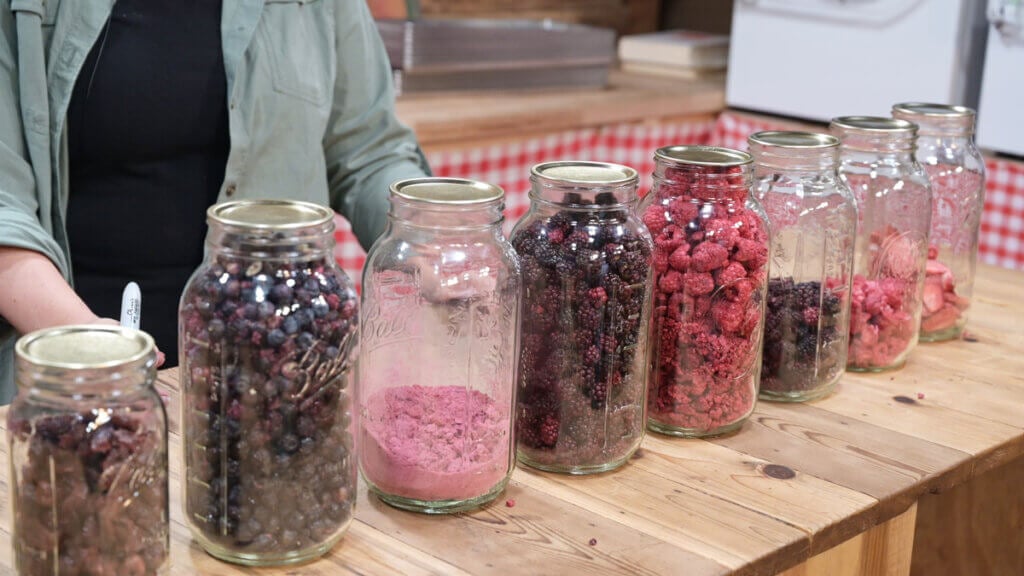
Why Stock Up on Food at Home?
There are many reasons we think it’s important to stock up on food at home, but here are the top four:
- Saves Money – Buying in bulk means the per-unit price is less. You’ll save money on fewer trips to the store as well as having fewer opportunities for those impulse buys.
- Saves Time – While fewer trips to the store mean saving money on gas, it also means saving time during the week. Though you may initially need to spend more time in the kitchen or pantry organizing the bulk buys, once you have a system in place, you’ll start seeing the time savings rack up.
- Food Security – If food security isn’t important to you after the events of the past few years, it should be. Having a well-stocked pantry means you’re prepared when the unexpected happens. Empty grocery store shelves won’t cause panic, and will give you peace of mind if you or a family member ever has an illness or injury that puts them out of work for an extended period of time. Furthermore, what you pay for food today will always be less than what you’ll pay next year, even if inflation is down.
- Less Waste – Every bit of the packaging, on smaller quantities of food, has an energy cost, a labor cost, etc., all bumping up the price per unit of the product. Furthermore, those smaller packages don’t always have the exact amount of food you need. We’ve all been there; you only need to cook 2 cups of rice for dinner, but your package has 2 1/2 cups. So you cook up the entire bag, package up the leftovers in the refrigerator, and, many times, end up throwing the rice away a few days later. When you buy in bulk, you don’t feel obligated to “use up” the rest of the package, just because it’s there.

Things to Consider Before Building a Long-Term Food Storage Supply
If you’re motivated to build up your pantry and long-term food storage, here are twelve steps we suggest you consider BEFORE going out and buying:
- Go Slowly – Don’t try to stock up all at once. If you start too quickly you won’t be in the habit of properly rotating and managing your food storage. The last thing you want is to spend a large sum of money only to find large quantities of food spoiled. This only leads to discouragement.
- Set Small, Achievable Goals – Start with a small goal and build up. Instead of starting with the goal of having a year’s worth of food, start with the goal of two weeks of food. Once you have a two-week supply, work up to a one-month supply. Then six months, etc. Our goal is never to have 25 years of food on the shelf. We like to work in a one-year rotation so we’re using up our food and replenishing each year.
- Zero-Out Your Food Supply – Once you have two weeks of food on the shelf, this is your new zero! Think of it like zeroing your bank account when it has $500 in it. You’re now zeroing out your food supply when you’re down to two weeks left. That will keep you from eating your food storage and having to start from scratch.
- Buy Items With a Long-Shelf Life – We recommend starting with items that have a long shelf life (a year or more), are inexpensive, and are easy to store, such as beans and rice. It’s not our recommendation to start with something that needs to be canned/preserved to make it shelf-stable.
- Have Ready-to-Eat Meals on the Shelf – Part of good meal planning is getting two full days of meals on the shelf (non-perishable) that you can just pop open the can and eat. Things like pasta sauce, dry pasta and canned veggies. These items can quickly be cooked and tossed together to make a complete meal. This will save you money on days you don’t feel like cooking because you won’t run to the grocery store for a quick convenience meal, and you won’t order out from a restaurant. This will free up more money for the following month to keep building your food supply.
- Consider Your Storage Before You Buy – When you buy in bulk, you’re taking the responsibility of dividing it up into individual serving sizes, which reduces the cost to you. But these larger items don’t usually come in a long-term food storage container. They will often be large boxes or bags that, once opened, are no longer safe from pests. Know how you’re going to store everything you buy so you have a place to properly store it all.
- Ideally, you’ll want a cool, dry location for most food storage.
- For dry goods, you’ll need airtight/sealed containers to keep pests out.
- We recommend using Mason jars and lids for smaller storage and two or five-gallon buckets with gamma-seal lids for larger storage.
- Our final tip for storing in bulk is to use labels! There’s nothing worse than thinking you’re grabbing baking powder for your recipe, only to use baking soda instead.
- You can learn how we store our bulk food and how to store vegetables without a root cellar.
- Buy What You’ll Eat – If you don’t eat pickled asparagus or pickled eggs, don’t stock up on them! They will inevitably sit on your pantry shelf for years to come, never getting consumed (essentially throwing your money/time away). Stock up on items you and your family will be excited about eating, this is super important! Think about the foods you enjoy on a regular basis and start there.
- Eat Seasonally – Start eating your produce when it’s in season. Produce in season is always cheaper than produce that’s out of season.
- Buy Local – Make relationships with your local growers. Even if the economy goes haywire, your local grower is still going to need to sell their product. By building a relationship now, you’re more likely to have a source when/if needed later on.
- Think Like a Producer (Not a Consumer) – Think first about the ingredients you use all the time and start there. For example, don’t buy bread in bulk, instead, buy bulk flour (or wheat berries) and make your own bread. You’ll end up with a better and fresher product, and it will save you a lot of money.
- Preserve Yourself – Once you have a good system for buying food in bulk, then you can start learning how to preserve items yourself. Even if it costs more to buy fresh green beans and can them yourself, the flavor of home-canned green beans far surpasses those purchased from the store.
- Grow Your Food – Finally, the biggest savings you will find when building up your long-term food-storage supply is to grow and raise it yourself. Learn how to raise a year’s worth of meat here and how to grow a year’s worth of food here.
How to Build a Long-Term Food Storage Supply
We’ve been building up our food supply for many years and have developed some great strategies. Here are our methods for stocking up on food, starting with our favorite!
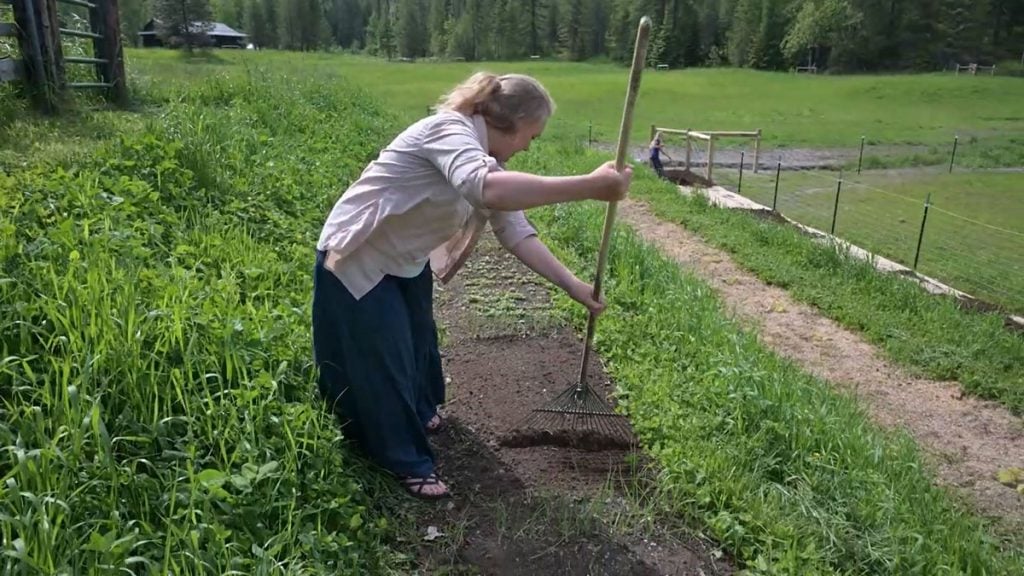
Grow Your Own Food
- Our very favorite method for building up a long-term food supply is to start growing and preserving food. This is the best way to stock up on food at the most affordable price.
- You don’t have to “grow it all,” just start small. Plant some berry bushes that you can harvest and freeze. Or grow a patch of lettuce for fresh salads. Learn how to succession sow to enjoy fresh salad all season long.
- Not only will you save the most money when growing food yourself, but you’ll get the best nutrition and the best value for your money.
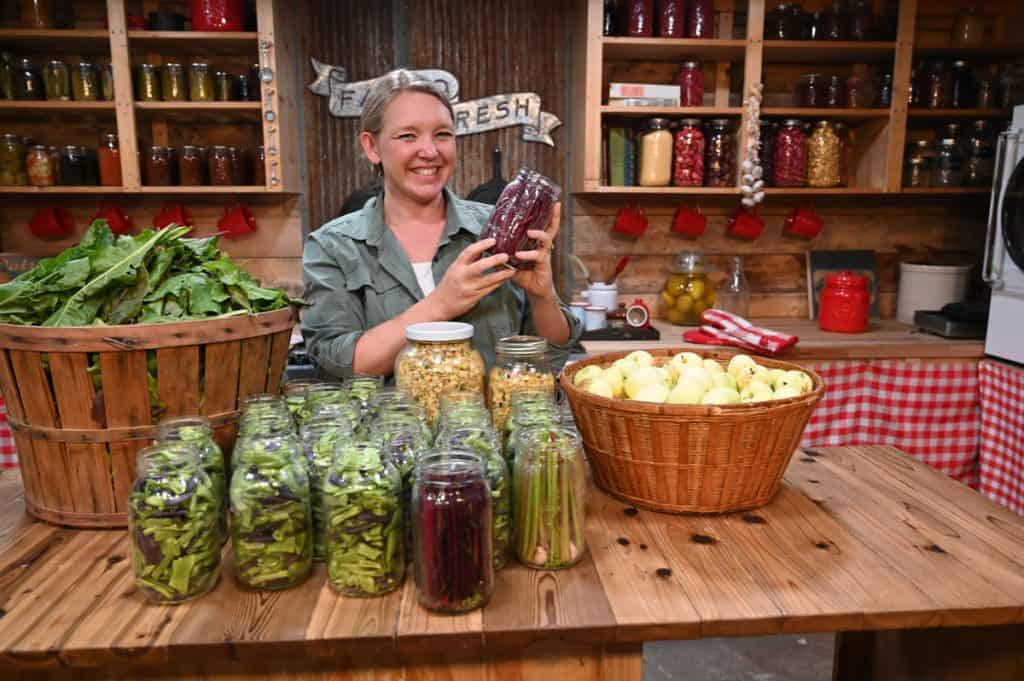
Buy Locally (In Season) and Preserve
- Find a local producer for meats, veggies, grains, dairy, etc. Anything you can’t or aren’t yet growing yourself. Buying local will mean your food is fresher, many times healthier, and hasn’t had to travel as far to get to you, lowering the carbon footprint on food production.
- Many times, entire communities will get together, truck in a large order from a farmer, and then divide it up. This may be an option if you’re not ready to buy such a large quantity.
- This method does, however, mean you need to be ready to preserve the food or to put it up for long-term storage. Learn how to prepare for the preserving season here!
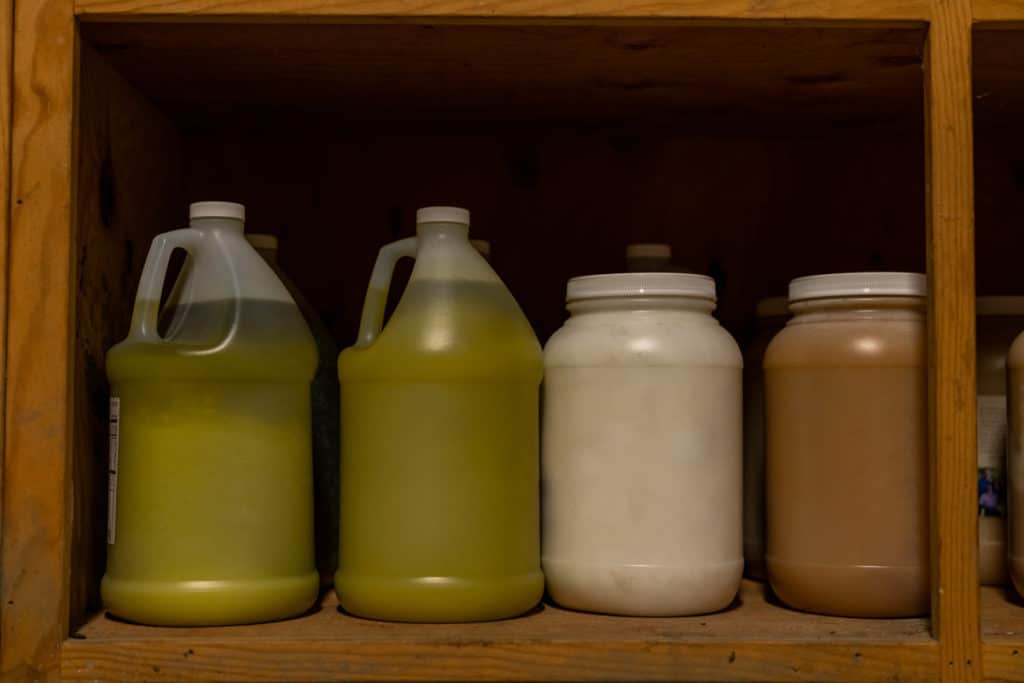
Buy Bulk Packages
- Buying in bulk saves you money because the price per unit is lower.
- Often, regular grocery stores will have a bulk-food aisle. This is a great starting point.
- Check out Azure Standard (available nationwide; some areas may not have deliveries nearby) – this is one of our favorite places to buy items in bulk that we don’t grow ourselves and can’t buy locally. Homesteading Hack: If you’re a first-time Azure Standard customer, use coupon code “HOMESTEADINGFAMILY15” at checkout for 15% off your order of $100 or more!
- Other options would be to find a bulk-buying store, such as Costco or a restaurant supply store.
- Check your area for a local co-op store to see if they offer bulk buys.
- Ask in local Facebook groups where people buy their food in bulk (it usually helps to be specific about what you’re looking for here).
Buy More Packages
- When you buy a package of food that will get you through a couple of days or weeks, buy an extra package or two to get yourself ahead.
- This is a great stepping stone to working up into buying 50-lbs bags of food. We can’t always start with such a large investment, but one extra package of pasta or jar of pasta sauce can be very affordable.
- If you shop at Costco or somewhere similar, sometimes you’ll find 6 packages of pasta sold together in a larger pack, but the price per unit will be smaller than if you bought each individual pack by itself. This can really help you get ahead quickly.
Make no mistake: in order to make bulk buying affordable, you have to have a strategy, you have to have a budget, and it’s best to start small. As you stock up, you will have one less thing to buy each month, which will give you a bit more money to put toward your next bulk item purchase.
Just be consistent and chip away at it one item at a time!
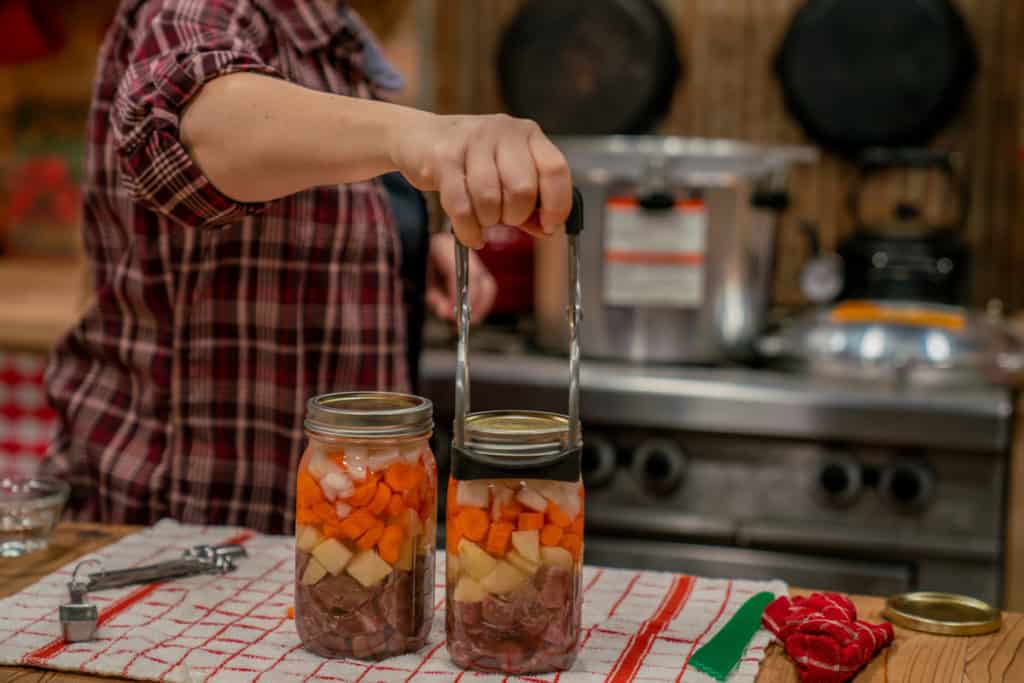
More Related Posts on Preserving:
- What to Do if You Can’t Find Canning Supplies
- Guide to Storing Apples (Fresh & Crisp All Winter)
- Eating Well on a Budget (With Tiffany from Don’t Waste the Crumbs)
- Food Preservation Calendar (A Year-at-a-Glance)
- How Long is Canned Food Good For?
- Foods You Should Not Dehydrate
- Prepping Your Pantry for Preserving Season
- How to Get Ready for Canning Season
- 3 Things You Must Do To Increase Self-Sufficiency
Josh: Hey guys, this is Josh.
Carolyn: And Carolyn.
Josh: We're Homesteading Family and welcome to this week's episode of the Pantry Chat Food for Thought. This week, we're going to be talking about building up your food storage. So starting to create a larder.
Josh: This week's episode of the Pantry Chat is brought to you by BCS two-wheel tractors. Now you may have already heard of the legendary versatility of BCS two-wheel tractor for small farms and homesteads. We love ours here on Riverbend. It's the most efficient and time-saving choice for a small acreage. Building raised beds with the rotary pile attachment, mixing in soil amendments with the power Herro, and shredding cover crops in place with the flail mower. But a BCS two-wheel tractor is more than just a gardening tool. BCS powers more than 40 high quality PTO driven attachments, each with the power and performance of an all gear drive transmission.
Josh: Blow snow with the BCS's snow thrower, chip and shred limbs and sticks with the chipper shredder, clean up your property with the pressure washer, haul up to 1,100 pounds, including yourself, with a ride on utility tractor. And even spread compost over 30 inch beds with the spreader attachment. Yup, BCS is pretty much the Swiss army knife of power equipment for your homestead. Check out bcsamerica.com to see the full range of tractors and attachments and find your nearest BCS dealer today. That's bcsamerica.com.
Josh: This week, we're going to be talking about building up your food storage. So starting to create a larder, a supply of food. And this applies to you not only if you're homesteading, or wherever you're at. Even in a totally urban environment, you can build up food security for cost savings, for being prepared, for better health, a whole lot of things.
Carolyn: Lots of good reasons there.
Josh: So this is a great topic, no matter where you're at. But before we get to that, let's move on.
Carolyn: Hey, if you want to skip out on the chit-chat check the timestamps in the description and you can skip right on ahead to the main topic that you just introduced.
Josh: Absolutely.
Carolyn: So, what's going on? Pumpkins. Pumpkins are going on a lot right now. We are starting to use up some of the pumpkins, we still have quite a few here. We brought in quite a few pumpkins from the garden this year. We have a couple of different varieties of my favorite, favorite pie pumpkins.
Josh: Is that the lecturey pie?
Carolyn: The lecturey pie is one of my [crosstalk 00:02:48] favorite.
Josh: That's one of our long-term, we've stuck with that variety for a very long time, lecturey pie.
Carolyn: If you have not grown your own pie pumpkins and you're used to just seeing those things at the store, buying those little ones at the store, you might be surprised because if you get a really good variety of pie pumpkin for us, lecturey pie has done really well, they can actually be very sweet and you need to decrease the amount of sugar in recipes. So I really like that. Because you can use less of a sweetener and have really good pumpkin pie.
Josh: And that means we get it for breakfast sometimes.
Carolyn: Sometimes we get breakfast-
Josh: I like that.
Carolyn: Yeah. Pumpkin custard for breakfast. That is in that-
Josh: The breakfast casseroles.
Carolyn: ... the breakfast casserole download.
Josh: Yeah, it's a free download [crosstalk 00:03:33].
Carolyn: I hope it's in there. If it's not in there-
Josh: Favorite recipes.
Carolyn: ... kick us.
Josh: Better add it and make it six.
Carolyn: We'll put it in there.
Josh: Yeah, that should be in there.
Carolyn: But look at this, this is going to come out as a how to in the next few weeks. This is a pumpkin spice dehydrator cookie. It's like pumpkin leather but it's pumpkin spice.
Josh: I got to test it but I didn't get it with the, is that coconut?
Carolyn: Coconut on the top and it's like eating a little bit of pumpkin pie, but it's in a healthy leather form, isn't that good? And shelf stable, so you can carry this great snacks for kids and it uses maple syrup instead of any sugar. So we really, really like that. And again, if you're using your own good pumpkins you can decrease even the maple syrup.
Josh: That was really good. Sorry, but that means we have to get the tea out, we got tea brewing today.
Carolyn: Yeah, we got a special one today. This is persnickety peach chai from farmhouse teas. If you guys haven't gotten any of their teas, yet you have to go check that out.
Josh: Yep. Farmhouse, teas CM, this is great.
Carolyn: Really good. Okay. So I've been dealing with pumpkins and cooking on the wood cookstove.
Josh: These go well together.
Carolyn: They go really well together. Really good. So that's me. What have you been doing?
Josh: Winter prep. We are still basically just getting settled in for winter, finishing up some work on the barn, getting in our wood shavings that we'll use for bedding in the barn. And we still have some winter prep on the garden that got put to the side. So we're trying to finish that up, getting all our beds amended and mulched and ready for spring. Hopefully going to get to rebuilding a bean tunnel. Lot of you guys have asked for how to on that, and I actually put them too close together and a couple other technical things since I want to move one and redo it, and I'm hoping to use that opportunity to create a video for that.
Josh: So we'll see if not this fall, this spring. But I'm trying to get to that soon as we're getting the garden ready for spring. And just a lot of really getting ready for winter with that, getting ready for hunting. I'm excited about that. Taking a little bit of break, things are starting to slow down and I'll get out, do a little hunting, hopefully putting some venison in the freezer. Though this is the first year here I'll be hunting, so it's a new area for us. So we'll see.
Carolyn: Good.
Josh: See how we do.
Carolyn: Yeah, you'll do great. That'd be good. Now. I don't think we've talked about how we got new chickens.
Josh: That's right. We've got new baby chicks, egg layers, 50 of them.
Carolyn: It seems a little-
Josh: Counterintuitive?
Carolyn: ... counterintuitive, thank you to be buying your egg laying chicks in the fall. But if you really want to get the best production out of your egg layers, you want them coming into their first lay season, right at the very, very beginning of spring, late winter.
Josh: Especially for those of us in a Northern climate.
Carolyn: Yes, right. So this is to get the best use of our eggs.
Josh: And one thing I'm excited about, I haven't talked about this much, but I'm working on a whole permaculture barn precept of integrating a lot of systems in the barn and the chicken coop is moving into the barn so that they can participate in helping in some of the other systems plus, so that they've got a little better environment. And out of the coop, so these chicks are getting started in the barn.
Carolyn: In the new barn coop.
Josh: Right. So even this winter, I'll get to let them out and they can roam the barn and help us in a few different ways. So I'm really excited about-
Carolyn: That's really neat.
Josh: ... yup, what we're going be doing there. Absolutely. Alrighty, so question of the day, this is actually, we got a whole lot of questions on this topic or several anyways, and it is about Carolyn's journal. We're interested in that journal where you got it and what's in it.
Carolyn: This is my book of secrets. This is my special book. I have been recording my favorite recipes and notes and all sorts of things in here. I've got, Oh wow, I have so many amazing recipes in here. I can't even tell you. I've got years totals of like my canned amounts. I've counted up canning amounts. I have not done that the last year or two. I just canned so much that I kind of lost track. We've got things like Josh's kielbasa recipes and-
Josh: We're going to get back to that and our breakfast sausage.
Carolyn: Breakfast sausage recipes. So one day guys, I am going to get this published for you. So you can see into this. One day, that's a far out project, but I'm still filling it for now with my super special secrets. But the book itself was a gift from Josh. It came from Colonel Littleton in Tennessee. They do fine leather work, and I love it. You can see it's kind of well used and beat up. It's got stains all over it and everything. Really nice. The only drawback I'd say on this is that it doesn't lay flat. If you're in the kitchen, that's a little hard.
Josh: They're internal, we've we've got a couple of these and these booklets are a little tough. Yeah.
Carolyn: Yeah. They're very nice, and it'll last a really long time.
Josh: Colonel Littleton's if you look them up, great small leather manufacturing company.
Carolyn: So anyways, that's it.
Josh: Cool, thanks for sharing. I wanted to share one comment by somebody though about your talk a couple of weeks ago, I think it was. On the how to put three homemade meals on the table. And this just summed up something we've talking about efficiency and production a little bit here and there. And chocolate box cottage. It sounds like a fun place, you'd like that.
Carolyn: Oh yeah.
Josh: Chocolate box cottage.
Carolyn: You know who chocolate bucks cottage is, don't you?
Josh: Oh, no, I don't.
Carolyn: You don't know?
Josh: I don't, I'm in the dark.
Carolyn: That is Michelle, who is our moderator. One of our wonderful trustee moderators-
Josh: I did not know that. Hey Michelle, now I know.
Carolyn: ... and our exclusive bread group for a class. In fact, I was going to give her a shout out today because she just started a brand new YouTube channel and she has great content. You guys, getting a YouTube channel started is really hard.
Josh: It's really tough.
Carolyn: So if you guys would do her a favor and jump over, I'll put a link in to her new channel, do her a favor of subscribing to bump up that subscriber count. But you know what? You won't be disappointed because she's putting out great stuff. She's a master preserver, a master gardener and I think a certified nutritionalist. She is an amazing, amazing person. She knows her stuff and you will not be disappointed with her videos. So hop on over and give her a thumbs up. But what did she say?
Josh: No, but that was a great segue.
Carolyn: You don't even know.
Josh: I do, I know. Michelle said, "Turning our kitchen into centers of production is a key strategy." She went on to a few other things, but I just loved that thought of thinking strategically about what we're doing and building skills and building up the homestead and the kitchen really is the start. A lot of people think about homesteading and going out and growing everything, and animals. And then of course it is, that's an integral part of it producing our own. But if you don't have the skills and the strategy in the kitchen, you're going to have problems if you're out here bringing everything in and connecting that loop.
Josh: And so this was also in regards to children and having children in the kitchen and working with them. And so there's an overall strategy there. But I just thought that was a real point and good. Just a good thing, a good thought there, Michelle. It is a key strategy for the life and the things that we are all working towards.
Carolyn: Right. Yeah. And if you don't have your kitchen working, most of the rest of the homestead's not going to work, right? Because most of it comes back into the kitchen one way or another.
Josh: Well, you end up with a lot of waste. You end up with a lot of wasted effort, wasted food if you don't have a good strategy there.
Carolyn: Yeah, it's very good to take that.
Josh: And including the kids and that really adds to that.
Carolyn: It does. Good.
Josh: Cool, all right. Well, I think we can get onto main topic, building up your food storage. And basically this is just some strategy and some tips that we've employed over the years and learned to go from week to week grocery shopping, or even month to month grocery shopping, to long-term storage and security. And that's both a great thing in light of just some of our modern production systems and of an overall homestead lifestyle. It's important. It's really integral.
Carolyn: It is. It really is. And it doesn't mean that you can't go still grab a few fresh things at the store here and there, sometimes that's nice, but it's building up that base supply of food in your home, right? So, okay, first off, why would you want to stock up? Why do you want to do that if you have a grocery store just down there? For us, the grocery store is half an hour away, so that's a great start of a reason why, but for some people, the grocery store' a block over. It doesn't take that long to get there. So why would people want to stock up?
Josh: Well, number one on our list is saving yourself money. Buying in bulk, stocking up saves you money,
Carolyn: It absolutely saves money.
Josh: How?
Carolyn: How?
Josh: A couple of the ways.
Carolyn: Yeah. Well, when you buy in bulk, you end up saving money on that because it drops the per unit amount on whatever you're buying. You know, sometimes as simple as doing something like going to Costco and you can go buy a big bulk package, sometimes that means more thinking behind it, like that, buying 50 pound bags of something.
Josh: Yeah, there's some resource development there in order to do that.
Carolyn: And we'll get into that a little bit more in a minute, but you just end up saving a lot of money on the product itself. But I've got to say you also save a lot of money, there we go, save a lot of money on trips to the grocery store.
Josh: I wasn't thinking that would be [crosstalk 00:13:30].
Carolyn: I don't know if you guys are that way, but especially if I'm shopping with kids, it's like, "Oh, let's grab a snack and let's grab this." And then, "Oh, I needed that thing, I just didn't put it on the list." And wouldn't that be nice to have? It's like the obligatory extra 20 bucks at the grocery store every time I go or whatever it is. If it's Walmart might be a little more or Target or something. We don't even have one of those around here.
Josh: Not really. But thankfully [crosstalk 00:13:52].
Carolyn: Just a big save money.
Josh: Well and that thought of it, not only is it saving you dollars by getting a better price point per pound, per volume, whatever it is, and you're saving money with trips to the store that leads right into saving you time as what's number two and the time spent shopping, right? It's not as many trips to the store and-
Carolyn: Driving.
Josh: ... it's dramatically saves time. Especially if you start factoring in having kids because you're a mom, you got to take the kids with you or dad, I've plenty of times I've taken the kids in the store, whatever it is that just takes time. And you're saving yourself time figuring out your lists and going and actually picking that food up.
Carolyn: Absolutely. Okay. So the number three reason you'd want to stock up on food. is-
Josh: I like this one. Food security.
Carolyn: This is a really good one.
Josh: It really is.
Carolyn: It's really important. And we should all have a base align of food storage in our homes somewhere, just for food security.
Josh: If you've been through hurricanes, if you've been... Gosh, it's been a while it seems like since we've had a major earthquake in this country, that's disrupted, but hurricane certainly tornadoes, even the fires in California, when you start having problems, the food on the shelves go fast-
Carolyn: In the grocery store.
Josh: ... in the grocery store. And so there's just one reason right there to have food security besides just our own being stocked up in the house and the flow of life.
Carolyn: Because even outside of a big disaster like an earthquake or hurricane, we all have those moments of little disaster. We all have those emergencies. We all have job loss and all of a sudden you don't have the income coming in that you expected. There are all sorts of different things, and having that food stocked up can really help buffer the effects of that.
Josh: And here's another one that really ties back to money a little bit that a lot of people don't think about. Our dollar is continually losing value. Inflation is continually degrading the value of the dollar always. Something bought today at a good price that you can bulk up on and you don't have to buy it six months from now, that may seem small, but it's better than money in a savings account. Your money in your savings account doesn't earn anything anymore in your regular savings account. When you make a good purchase at a good price and you can hold onto that and use that out into the future, you're fighting those inflationary effects. And so for me, that's a big one. That is, it's a money saver and it's a security, it's a hedge against that.
Carolyn: Well, and anybody who's been shopping for the last few years has really seen that because the prices are going up and up, especially for good quality food.
Josh: Yep, absolutely.
Carolyn: Number four reason, I really like this one. You waste a lot less. You have a lot less waste. If you're buying in bulk or if you're producing something yourself, you're not getting all the waste from the little packages of things. Years ago, you and I started measuring some amount of our self-sufficiency by how much waste we were producing and trying to decrease that it's a great way to measure whether you're bringing in a lot of stuff or if you're producing it yourself. Because you just have a lot less waste when you produce it yourself or when you buy bulk.
Josh: And we tend to think of using less energy and less waste a lot of times in light bulbs and energy usage, that's true but every bit of that packaging has an energy costs to it. Every bit of it. Just like there's an energy cost to going back and forth to the store more times. And so, it's not only less waste in plastic, it's less waste in energy overall. And of course producing for ourselves ties into this, but the more we can buy in bulk, you're wasting less energy.
Josh: I think another one, and this is probably particular to us in a larger family is that, you can tailor when you buy in bulk and you're therefore taking your food, say your wheat or whatever it is, you can tailor it to the sizes for the meal for that day or for whatever you're cooking. So you have less tendency to over make something and not use it and let it go to waste.
Carolyn: Yeah. I like that thought. I hadn't thought of that one.
Josh: Cool. So those are our key four, there's probably some other ones we could come up with, but good reasons why it's a good idea to start down this journey of stocking up and building up and extended food storage.
Carolyn: So as we get into the particulars of how to do this, how to stock up, we've come up with five different rules that you really need to consider, follow, pay attention to, at least acknowledge before you start stocking up on food. Okay?
Josh: You want me to take it? I'm going to take it.
Carolyn: Yep.
Josh: Okay, rule number one, stock up on what you will and do actually eat.
Carolyn: This seems silly.
Josh: Don't just go buy a bunch of dried goods that are going to go in the back somewhere that you're not interested in.
Carolyn: If you don't eat canned asparagus, don't put a bunch of it on your shelf. You're not going to like it later any more than you like it now. So, just make sure that you are actually filling your shelves with things that you do eat, you want to eat, you like eating, your family will eat all of those things. And that seems so obvious to say, but so many times I've heard from people who are like, "I got all this stuff, I don't like it. What do I do with it now?
Josh: There's one went and bought a bunch of bulk stuff to have some security on the shelf for an emergency or whatever, and then only think about how useful it was. And so I don't know if we talk about it later in here, because when you do that, that fits into a rotation, right? And so you're always using your bulk stuff, just piling it in the corner.
Carolyn: If you're always eating off of your bulk supply, then that's not a problem. That's a good way to go. Okay.
Josh: Rule number two, stock up on ingredients to pantry meals first so you have a backup. Would you explain that?
Carolyn: Okay. All right. That was my note. So pantry meals, something that you can make right out of your pantry because you have all your ingredients. A classic example of that would be spaghetti. You've got your noodles, you've got your spaghetti sauce, you've got a meal. Maybe you have some canned meat ready to go and you have a meal that can come straight out of your pantry. You don't need additional ingredients.
Carolyn: Make sure that as you start stocking up, you think through a few meals that your family would eat normally and make sure you stock up on some of those things first so that you're giving yourself a backup. And this is really important because that means you will save money on going out to take out or buying the convenience meals from the grocery store, things like that at last minute moments. That'll give you more money to get more food supplies next month.
Josh: Right, absolutely. And we'll talk about ways to stock up strategy here in a minute which will help things how to do that, because that can be a challenge.
Carolyn: Yeah, it really can.
Josh: How I enter into that because the purchases are larger. And so that's hard on the budget to get started. Yep. But to keep things moving along here, rule number three, prepare your storage space and or method before you stock up.
Carolyn: Right. We spent a whole pantry chat on that last week. So go watch that one, but make sure you have something to do with the bulk amounts of food you're bringing in. Because it's as simple as that, you know?
Josh: And let me segue, it doesn't have to be perfectly ideal.
Carolyn: No, it doesn't.
Josh: So as a say, you're going to get a bunch of a winter pump, storage squash, sorry, winter pumpkins and you don't really have the ideal place for it. You can still find niches and places to that. You can buy apples in bulk and find places for it. Root crops, there's a lot of things, whether you're growing them or finding a deal and buying in bulk, you don't have to have the ideals, but you do want to plan ahead of what you're going to do. You don't want to go home and go buy 150 pounds of potatoes and then come home and figure out what to do with them
Carolyn: Right, no. Yeah, that'd be forehand. Okay. Rule number four,
Josh: Change to a producer mindset. Start learning to buy bulk and or, and it would be a and grow and raise your own food. So that you can make your own.
Carolyn: Yeah. Mostly your ingredients, right? So if you're buying things or if you're raising them, buy the ingredients to something and make your own.
Josh: And that's where you're going to have a lot of savings.
Carolyn: That's where you're going to have a lot of money savings. Instead of trying to buy bread in bulk, it's a lot more cost-effective to buy in wheat, whole wheat and make your own bread. Not only are you going to end up with a better product, you're going to end up with a fresher product in the end and it's going to be a lot, lot cheaper.
Josh: And you know, I want to say again, and we've talked about this from time to time. Buying in bulk is a great skillset for entering into the homesteading lifestyle. If you're not there yet, and you're working on transitioning and you're thinking about where you put your resources right now, how do you build skills? Buying bulk is huge. Not only does it save you money, it teaches you a skill because things are seasonal. On the farm, your meat comes in all in bulk. Your vegetables come in all in bulk. You want to buy your feed at a certain time of the year, there's so many things that happen in bigger batches and you have to learn how to produce that way and consume that way.
Josh: So even if you're not producing by buying in bulk and getting into that mindset and that skill, you're producing a lot of skills that are very conducive and needed to furthering the homesteading lifestyle.
Carolyn: Right, absolutely.
Josh: Okay, so one more.
Carolyn: Rule number five.
Josh: That's right. Know how long what you're buying is going to last and buy appropriately. Some things are going to last longer than others. So you got to consider that you probably have-
Carolyn: Yeah, if you're buying something like dry beans, those will last just fine in a bucket on your shelf for five years. You can buy a lot of dried beans and have them last a long time.
Josh: As long as they stay dry. In some environments, they may need [crosstalk 00:23:41] to be sealed or something
Carolyn: Right. But if you're buying olive oil, you don't want that sitting on your shelf for five years. It's going to go [crosstalk 00:23:50].
Josh: No matter how it is contained.
Carolyn: You need to be buying that at least every year from a good source, maybe even more often, if your storage area is not ideal. So, know what it is you're buying, know how much of it you are going to consume in it's good period and only get that amount.
Josh: Good.
Carolyn: Good.
Josh: Great. So, okay, there's some how to. Now we want to talk about ways to starting to stock up. Ways to get this going, right?
Carolyn: So this is kind of our countdown to our favorite ways. We have four ways to stock up here. And okay, number four is-
Josh: Buying-
Carolyn: ... the buying more packages.
Josh: Okay, buy more packages.
Carolyn: Buy more packages. That does not mean go buy more packages than you're already buying, but it does mean if you're going to the store to buy something, instead of just getting one of them that will get you through a few days, maybe a week, maybe even a month, buy two, buy three, buy four stock up on your shelf and get ahead a little bit. That way you start always having a rotation where you say, "Oh, I'm down to three of these things, I need to buy a few more." And that just makes sure you always have the supply, you're never running out
Josh: This helps with your budget too, because you have to start budgeting differently when you buy in bulk. And so going out and buying 50 pounds or 100 pounds of something can be challenging all of a sudden. You say, "Okay, I'm going to start buying in bulk." And you start doing it, and go, Whoa, this is a big bill. And it is. And so transitioning the way Carolyn's talking about at first, keep buying the small thing you were buying, but maybe buy double. And then the next time you can afford it, buy a little bit more and you start to condition yourself and your budget. You can start budgeting for that and work up to those larger purchases that are really required to do bulk buying well. By buying those more packages.
Carolyn: Well, and another thing that we, I think we touched on in last week's video a little bit is that when you start bringing in bulk things, your storage systems have to change and sometimes that means you need to purchase containers or something to store large amounts. And so if you do that kind of gradually, it spreads out that cost a little bit, which is a good thing.
Josh: Yeah, and work up to it. Absolutely.
Carolyn: Absolutely.
Josh: Okay I think we're going here.
Carolyn: Yep. So next is...
Josh: To buy bulk packages.
Carolyn: Yeah, move up in size. Now sometimes grocery stores have bulk package aisles and buy bulk packages-
Josh: So like Costco, the Costco idea.
Carolyn: Sometimes Costco has big bags of things. Sometimes they have a bunch of little things packaged together. The little things packaged together kind of counts as the buy more, right? The big bags of things, that's where your real cost saving comes in. That is the bulk packages. Now a place like Costco, Box Stores sometimes has that sort of thing. But you can also into one, your local food co-op. Go to your local health food store and ask about bulk buying opportunities. There may be a group in your town, a lot of places there are groups that order directly from bulk buying companies.
Josh: You got to dig for that sometimes to find that. So don't just take one or two answers and think it doesn't exist. Sometimes it's just not-
Carolyn: Ask on your local Facebook groups. Just start asking around, where can I buy bulk foods? Another one to look into is Azure Standard. We'd love to Azure Standard. And that is a bulk buying opportunity where they deliver to your town. You go meet the truck and get your bulk foods. It's a really, really-
Josh: And it's a wonderful system.
Carolyn: It really is.
Josh: I wish there was more localized suppliers like them, but they've just done it so well. And they're one of the few that do what they do. And so it's a great entry place and we still rely on them from time to time.
Carolyn: We still buy, there's things we don't produce and we buy in from them. So yeah, real good. So those are some great ways to get some bulk packages. And in bulk buying that's one of those places you really have to make sure you have your packaging ready, okay? Don't go buy a bunch of 50 pound bags of-
Josh: You're storage ready.
Carolyn: ... your storage packaging. Yeah, for when it comes in the house, because you can't just leave those things in the bags.
Josh: Especially a lot of your grains. We buy all our grains in bulk, our sugar, our salt, our flour or rice or beans or coffee. You can, but it doesn't work well just leaving them in the bags.
Carolyn: Yeah, you end up with pest problems.
Josh: The past problems and [crosstalk 00:28:10],
Carolyn: There's problems.
Josh: So you need that storage solution first.
Carolyn: Yeah, so look into that before you get going on that. We'll try to put the link to Azure Standard down since we mentioned that.
Josh: Sounds good. Okay, so next would be to buy bulk from a local producer in season and preserve and store.
Carolyn: So this is our second favorite option for bulking up your food supply, right? Find a local producer.
Josh: And this, this can be for meats, vegetables, depending on where you live, grains. Most places today, there's going to be some relatively local producers for quality meats and quality vegetables. That's just growing more and more.
Carolyn: Dairy.
Josh: Dairy, that's growing more and more. And so there's lots of different ways to put that up and store it bulk. And then you have your grains and a lot of those, depending on where you're at, you may or may not. That's very regional. And so that may be harder and you may need even to buy in bulk, Azure standard or some co-op like that.
Carolyn: Yeah, and sometimes communities get together and do a really big order and truck it in from a farmer who's further away. We know that happens here quite a bit and that works out really well if you can get a community together. Now, what comes with that though, is that you do have to preserve food if you're buying fresh food, fresh produce in bulk in season, which is a great way to do. But you do need to learn how to preserve it the food.
Josh: Got to be ready to preserve it, to can it, to dehydrate it, to-
Carolyn: Freeze it, ferment it.
Josh: Yeah. And this is the one people kept talking about freeze drying it. This is something we will get into eventually, but we feel the entry cost at this point is still too high to make it worthwhile for our worthwhile and for most of you. But it's getting there, it's coming down and it's an awesome food preservation method though. It's a little energy intensive, but you want to talk about storing some of those other foods, fresh foods that are hard to store long-term other than canning, which is great.
Carolyn: I want to do avocados freeze dried. There's just no other way to do avocados that are any good. So yeah.
Josh: So for those of you that are thinking of that yes, so that is an excellent option other than the energy consumption and the price points to enter. So we plan to do that eventually, but still waiting for those prices [crosstalk 00:30:20]
Carolyn: To come down a little bit?
Josh: I'm aware of the technology.
Carolyn: Drum roll [crosstalk 00:30:24].
Josh: Can you guys guess it, what's our number one method for stocking up your food storage?
Carolyn: I know, I know.
Josh: You, young lady, pretty young lady.
Carolyn: Grow your own. Grow your own food.
Josh: Yep. Start to grow your own and preserve your own. None of us can do all of that for ourselves, 100% of it, but a lot of us can do-
Carolyn: Something.
Josh: ... something to a lot of it, Absolutely.
Carolyn: Absolutely. You're going to get the best nutrition, the best value for your money put in, the best other benefits, like being out in fresh air. So it's a really good way to go.
Josh: Absolutely. And that's a journey, so just keep hanging with us and we'll keep talking about all that because that's what we like to do.
Carolyn: We really do. Okay, before we wrap this up, we talked about a method, helping people, the economics.
Josh: We talked about why?
Carolyn: We talked about why.
Josh: Yeah, I feel like we're recapping.
Carolyn: Oh, okay. No, I wasn't recapping. I've said we promised to talk about the economics and how to get started on buying bulk. Because sometimes you go to buy that 50 pound bag of beans, it's more expensive than a one pound bag of beans. [crosstalk 00:31:32].
Josh: And it doesn't fit in the budget to start.
Carolyn: Right, it might not. So how do we do that to make that worthwhile?
Josh: Well, you got to have a strategy and you have to start small, right? So I think you who you handle the food budget, so you start to just increase little bit to that food budget. Is that how you've done it?
Carolyn: Yeah. As you stock up, you have one less thing that you have to buy every month. Because that 50 pound bag is going to last you a long time if you're used to buying one pound bags every month. So then all of a sudden you have one less thing you have to buy. So you can roll the money you would've spent on that one pound of beans into buying something else bulk. Doing it that way, starting to bulk up on a new thing every month is a great way to get into it without spending too much money on it. And that's a great entry way for it.
Josh: And you just start to grow that. And another thing I would add is consider seasonality when you're picking what things. You know, start bulking up on certain things in their season. And that just starts to get you into a rhythm and you'll grow into that as you can increase that. And it just means that the other side you have to do is you have to start to save a little bit. You can't roll it just all over. You've started to go up to put a few dollars away every time so that those purchases continue to get larger and larger until you can get to the cycle that you want. We kind of aim for a one-year cycle generally, right?
Josh: But whatever that is for you, six months a year, for some people, maybe it's longer, but you need to be able to save a little bit at the same time as you're increasing other ones so that you can keep growing. And so little steps along. You've heard us say start small, it's a great place to start small and with a good strategy, you will just increase your food storage and your ability to take advantage of better deals and all kinds of stuff.
Carolyn: It really, yeah. It grows really quickly if you can just be consistent, but chip away at it.
Josh: Thanks for listening to this episode of the Pantry Chat Food for Thought. If you've enjoyed this episode, please subscribe, rate, and review.
Carolyn: To view the show notes and any other resources mentioned on this episode, you can learn more at homesteadingfamily.com/podcast.
Josh: We'll see you soon.
Carolyn: Goodbye.
Sign up to receive email updates
Enter your name and email address below and I'll send you periodic updates about the podcast.











